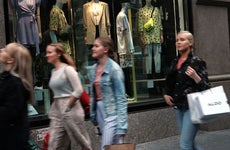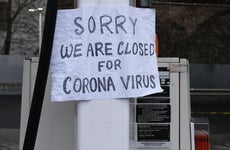Has the world really reopened?

The Bankrate promise
At Bankrate we strive to help you make smarter financial decisions. While we adhere to strict , this post may contain references to products from our partners. Here's an explanation for . The content on this page is accurate as of the posting date; however, some of the offers mentioned may have expired. Terms apply to the offers listed on this page. Any opinions, analyses, reviews or recommendations expressed in this article are those of the author’s alone, and have not been reviewed, approved or otherwise endorsed by any card issuer.
“The pandemic is over,” President Joe Biden told 60 Minutes in an episode that aired Sept. 18. Tedros Ghebreyesus, the director general of the World Health Organization, doesn’t believe we’re quite there yet. “The pandemic is not over, but the end is in sight,” he told reporters on Sept. 14.
It’s not just health experts and politicians quibbling over semantics. We’re also seeing conflicting signals regarding COVID-19’s lingering effects on consumer behavior and the economy.
Travel hasn’t completely rebounded
Travel is an important sector of the economy and one that provides particularly interesting insight into this question. Before the pandemic, the Transportation Security Administration routinely screened more than two million passengers daily. The figure bottomed out at just 87,534 on April 12, 2020, about a month after COVID-19 was officially labeled as a pandemic. That marked a 96 percent year-over-year decline.
This past summer, most people who traveled by air probably would have said the experience felt more or less back to normal. Masks were no longer required, planes were full and it felt like travel was back. The numbers tell a somewhat different story, however.
The TSA screened 25 million fewer passengers between June 1 and Aug. 31 of this year versus the same dates in 2019 (a 10.6 percent decrease). FlightAware reports that 13 percent fewer flights were scheduled this summer than three years ago. That’s why most planes felt full even though fewer people traveled by air.
The perception has been that leisure travel demand was rebounding faster than business travel demand, but that may be changing. Surprisingly, average daily TSA screenings are only down 6.4 percent when comparing Sept. 1 through Oct. 20, 2022 and the same period in 2019. There’s also a theory that more people are working remotely and taking extended weekend trips, sometimes mixing business and leisure (“bleisure”). Whatever the cause, air travel is looking more and more like pre-pandemic times this fall, even as kids are back in school.
Hotel occupancy rates also remain about 3 percent below 2019 levels according to STR, but the gap is narrowing.
Dining: A mixed bag
OpenTable is observing an interesting pattern at U.S. restaurants: The number of seated diners is typically down a few percentage points on weekdays and up a little bit on weekends. This may reflect fewer business meals and stronger leisure demand.
Americans are spending more at bars and restaurants, even after accounting for inflation. The Census Bureau found that sales rose 11.2 percent year-over-year from July 1 through Sept. 30. Annual inflation in this category was measured at 8.5 percent in September, according to the Consumer Price Index published by the Bureau of Labor Statistics.
Shoppers choose experiences over things
Services spending expanded 5.5 percent from January to August of this year, according to the Bureau of Economic Analysis. That was more than double the 2.6 percent growth rate for goods spending.
The increase in services spending is likely an example of pent-up demand that accumulated during 2020 and 2021 when travel and dining were less accessible. The opposite happened during those years: Demand for physical items surged as people spent a lot of time at home. Instead of going on trips or out to restaurants, concerts or sporting events, they busied themselves with home renovations, electronics and exercise equipment.
Unemployment remains low, despite other economic concerns
The job market has been very strong, which is helping power this spending. The current unemployment rate is just 3.5 percent. That’s tied for the lowest level in a half-century. Average hourly earnings are up 5 percent over the past year, but with inflation clocking in at 8.2 percent, that helps explain why consumer sentiment has been so depressed.
Still, most people have more money in the bank these days. Bank of America says its customers’ deposit balances are between two and five times higher than they were just before the pandemic. This helps explain why delinquencies and defaults remain extremely low relative to historical norms.
Everyday commuters decline
Speaking of employment, schlepping into the office five days a week is a thing of the past for many workers. Nationally, the number of people primarily working from home has tripled since 2019, per U.S. Census data.
Many companies have switched to hybrid models, perhaps requesting employees to appear in-person two or three days a week. Just 9 percent of Manhattan office workers are in the office five days a week, according to a survey conducted by The Partnership for New York City. Roughly half are present on an average weekday. This is a change that I’m cheering for, personally.
The bottom line
In some respects, we’re back to our pre-pandemic habits. For example, restaurants and stadiums are full houses once again. But I still harken back to something I remember hearing when we started to tentatively emerge from our COVID cocoons in the summer of 2020.
To paraphrase: Anyone more cautious than you concerning COVID protocols is crazy. And anyone less cautious is crazy, too. I still see a wide range of outcomes among friends, family and acquaintances. I know some people who still wear masks in public and refuse to eat in busy restaurants. Others haven’t been concerned about COVID in quite a while, if ever. And then there are the squishy etiquette questions. Are we supposed to shake hands with someone we just met at a cocktail party?
Even inflation, the dominant economic theme of 2022, is hard to pin down. Was it caused by too much stimulus in the early days of the pandemic? Were COVID-related worker shortages and supply chain maladies to blame? Is it all Russia’s fault?
Like most things, the truth is probably somewhere in between. But as we’re left wondering if things are back to normal and whether or not we can throw out our masks, there are still many unanswered questions.
It has certainly been a wild ride dating back to when “two weeks to flatten the curve” and “social distancing” were the catchphrases of the moment. Now we’re pondering revenge travel, the Great Resignation and whether or not the Fed will hit the brakes so hard that we tip into recession. We’re thankful for the progress on the health front, even as new challenges have emerged.
Have a question about credit cards? E-mail me at ted.rossman@bankrate.com and I’d be happy to help.
Related Articles



Unemployment benefits and coronavirus: Here’s who qualifies and how to apply

The credit card market is officially booming: Here’s what it means for you